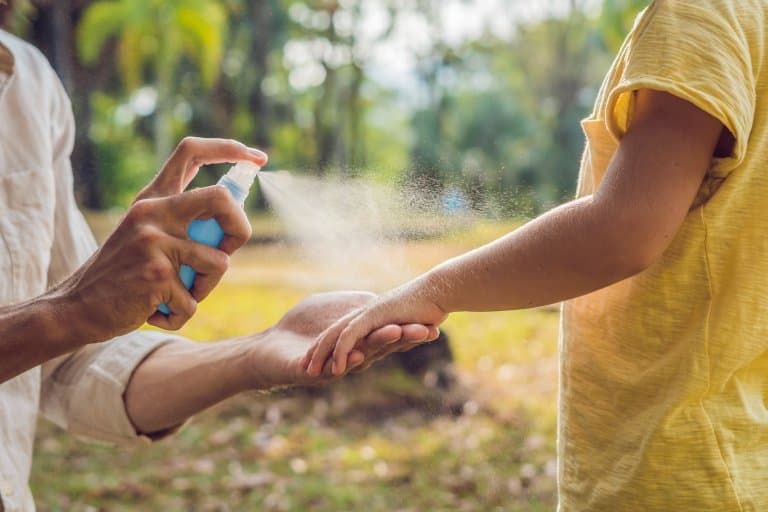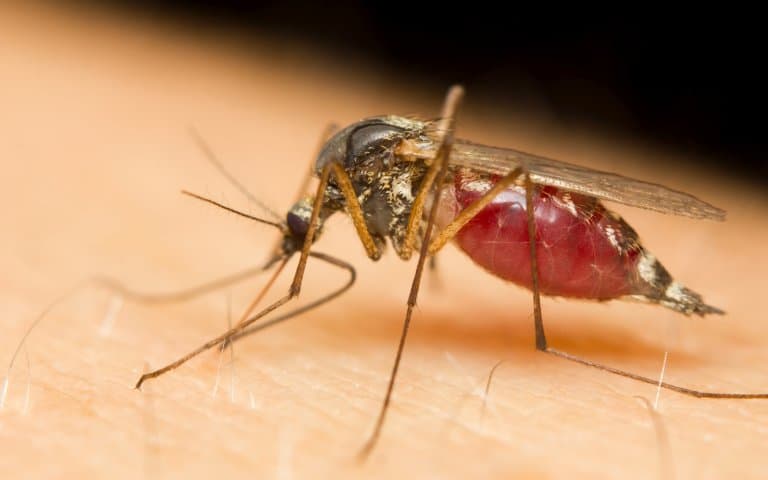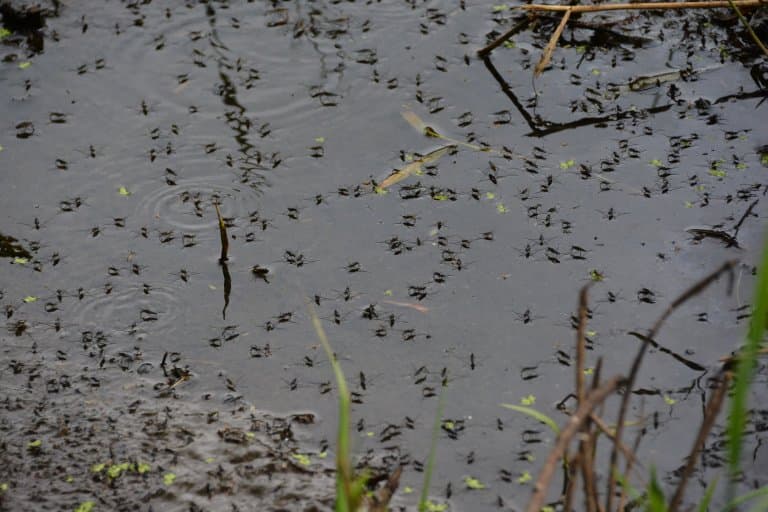Mosquito Profile
Mosquitos are small flies that are found all over the world, except Antarctica and a few small islands.
There are over 3,600 species of mosquito, and while they are best known for their adult form, they go through an egg, larva and pupa life cycle before their adult fly form.
Of all the dangerous organisms in the world, the single most dangerous is, debatably, one of the tiniest. Technically, it’s microscopic.
Plasmodium falciparum is thought to kill millions of people by invading blood cells and attacking the brain. Yet, this tiny parasite can only travel via a much larger, winged insect.
One that’s so perfectly specialised to carry and transmit this deadly threat which causes malaria, and plenty of other diseases along with it.
The small, bothersome bug that bites leaving an itchy rash is more than just a nuisance. It is by far the worlds deadliest animal.

Mosquito Facts Overview
| Habitat: | Almost anywhere with still water |
| Location: | Worldwide except Antarctica |
| Lifespan: | One week to months, depending on the species |
| Size: | 2 – 19 mm |
| Weight: | Flyweight |
| Color: | Usually gray, sometimes striped, brown or white |
| Diet: | Nectar, fruit juice, aphid honeydew, sometimes blood |
| Predators: | Almost everything: mammals, reptiles, birds, amphibians, other invertebrates |
| Top Speed: | Slow in Europe, impossible to slap in Africa, medium-speed in Asia |
| No. of Species: |
3,600 + |
| Conservation Status: |
Not listed |
Mosquitos are true flies, meaning they have one pair of wings – as well as slender bodies and typically measure 3-6 mm in length and are dark gray or black in colour.
Like all flies they go through four stages in their life cycle from egg to fly. The first three stages are largely aquatic, before they reach fully adult fly form.
Mosquitos are one of the most important animals on the planet. Their aquatic larvae feed all kinds of underwater animals and the adults provide a huge amount of biomass to the countless birds, bats, and insects that make up the higher levels of the trophic web.
Yet, they have a destructive force too, at least to humans and livestock. And the diseases they spread transmit from animal to animal due to a phenomenal feat of evolutionary brilliance.
A specialised set of sensory and surgical instruments attached to this tiny insect make it far more complex and impressive than is obvious at first glance.
Interesting Mosquito Facts
1. Only female mosquitos bite
Only females have the mouth parts necessary for biting and sucking blood. They use the blood as a source of protein for their eggs, rather than for their own food.
The size of the bloodmeal depends on the species, however, they are able to drink their entire body weight in blood during a single meal.

2. Most of them eat nectar, rather than blood
Contrary to their infamous stereotype, the majority of mosquito food comes from plants. The males of almost all species exclusively eat nectar, and the females rarely feed on blood as a source of nutrition.
In species that do, it’s generally to top up what’s missing from a low nectar-flow season and wouldn’t be the primary nutrient source.
To put it in perspective, there are around 3,600 known species of mosquito, yet there are only around 100 species of insect that feed preferentially on human blood.
There are, however, some generalists in this list, and of the mosquitos, this includes roughly 250 species that may occasionally bite people. Of these, roughly 90 are vectors of diseases.
However, blood is a common source of nutrients for the eggs of many species, and that’s where the problems arise. 1
3. They’re pesky little mass-murderers
Malaria is something everyone’s heard of, and it’s thought to cause over 600k deaths a year.
These deaths are mostly in children, and represent only a very small fraction of the hundreds of millions of annual cases of malaria across the world.
The disease doesn’t come from the mosquitos directly – instead, it’s transmitted by them. The malaria-causing parasite can’t exist outside of tropical and sub-tropical regions, which is why it’s more common in Asia and Africa than Europe and the US, for example.
It’s estimated that around 5% of people who ever lived succumbed to a mosquito-related disease. 2
4. Mosquitos are the world’s deadliest animal
In 2021 there were 247 million cases of marlaria worldwide. It’s estimated by the World Health Organization (WHO) that the number of malaria deaths stood at 619,000 in the same year.
Africa was home to 96% of these deaths, with 80% being childern under 5 years old. While malaria is preventable, and curable, it’s always the poorest countries that suffer without enough help.
Still, malaria isn’t the only problem that’s spread by mosquitos. Yellow fever, dengue, Zika, and West Nile viruses are all spread by these little buggers, and a number of other parasitic diseases contribute to around a million deaths per year as an indirect result of mosquito bites. 3

5. They don’t just bite humans
Actually, they don’t just bite mammals, or even just vertebrates! While some species will take on frogs, fish, birds, or lizards, there are even species that will feed on worms and leeches.
Leeches may represent another dangerous factor in the spread of disease since many of those will feed on blood too.
The question is how varied are the meals within each species. For example, a species that only feeds on leeches is not going to be responsible for spreading mammalian diseases, even if the leech is infected with one.
However, if the leech is full of infected cow blood, and the mosquito feeds on an infected leech before topping up on a human host, they could be at risk of passing on something scary.
Surprisingly, despite being such a threat to human health and having billions of dollars a year funnelled into their research, mosquitos are still keeping their cards close to the chest. 4
6. They are exceptionally specialised
One of the reasons for their trickiness is just how intricately adapted they’ve become to what they do.
Mosquitos arrived just before the extinction of the dinosaurs. This means they’ve evolved alongside the rise of mammals and have been present for the duration of human existence.
They are a part of the human genome, in many ways, since their presence has literally affected the evolution of our DNA. For example, the sickle-cell condition is thought to be an adapted response to the presence of the malaria parasite – haemoglobin molecules that are a bad shape for it to bind with.
So, there has been a lengthy arms race between humans and mosquitos in terms of evolution, and the mosquito has fought back well.
They use a vast array of sensory organs and environmental cues to find us. First, they can pick up on CO2 that’s expelled from our breath.
Then, they use a uniquely specialised olfactory system that picks up on a range of smells that have as-yet been fully identified.
Following our body odour and our breath, the mosquito then gets close enough to pick up on body heat and visual cues. This is why they don’t just fly up your nose while you’re sleeping – something which would likely result in you squishing them. 5

7. They can sniff out blood vessels
Even our blood releases odours through our skin that the mosquito can pick up on. After landing, they switch to the short-range senses to try and find the thinnest patches of skin to hunt for an easy-access capillary.
Sniffing out an accessible blood vessel can take just a couple of seconds, and then it’s time to move onto the next highly specialised set of tools in the animal’s arsenal. 6
8. Mosquitos do prefer biting some humans over others
Some people just seem to get bitten more by these irritating bugs, and it turns out it’s not a myth. Researchers have found some evidence as to why, as it appears mosquitos have feeding preferences.
They prefer those with type O blood, heavy breathers, skin bacteria, high body heat and pregnant women. 7
9. They have a six-piece mouth
The business end of a mozzie is yet another remarkable evolutionary masterpiece. It consists of six major spiky bits, called stylets.
You’ve got the maxillae, which are essentially the upper jaws present in most animals. In the mosquito, they’re paired, elongated, serrated, and used as little saws to cut open a pathway in the skin.
Then, the mandibles, the lower jaws, are similarly paired, and act as surgical retractors, holding open the incision.
From there, anaesthetic and anti-coagulant saliva is injected into the wound from yet another needle-like hypopharynx to both hide the event from the host and keep the blood flowing.
Finally, a hollow labrum acts like a straw, sucking up that sweet, sweet, juice. The saliva is how passenger pathogens are passed into the host’s bloodstream.8

10. They have provided inspiration for needles
This Edward Scissor-Mouth setup is so perfectly designed to minimize tissue damage and displacement that it’s become a focus of attention for the designers of medical apparatus.
In a beautiful twist, the mosquito is now having a positive medical impact by providing the inspiration for a new generation of sampling needles.
This is called Mosquito Proboscis-Inspired insertion and is yet another way that design is being inspired by the evolutionary successes of animals. 9
11. Mosquitos grow up fast
Like all flies, mosquitos go through for life cycle stages – egg, larva, pupa and adult fly.
Each stage of this life cycle can typically last between 5 days and 2 weeks depending on the species and strongly influenced by ambient temperature.
Some species can mature much faster, and the life cycle from egg through to an adult mosquito can be as little as just 7 days.
Not only do mosquitos grow up fast, they don’t last long. An adult lifespan can be as short as a week, or some species can live for several months.
12. They breed in still water sources
The first three stages of their life cycle, egg, larva and pupa are spent in water. In most mosquito species, they lay their eggs in still, stagnant water.
Some species will lay their eggs in lakes, or puddles, while others will lay them in marshes, or rainwater in tree trunks or even plants.
Some female mosquito species will fly over water and drop off anywhere between 100-200 eggs. Others will land on water and lay their eggs in rafts that stick together and float on the surface.
Larvae are then born and spend much of their time feeding on algae and bacteria. At the end of this life stage, they will molt, and move to the pupa stage. There’s no feeding in this stage, and they will typically float about in water, before they molt again into an adult mosquito.
They mate within days of emerging as an adult, to start the circle of life again.

13. The can’t survive below 10 degrees (50 F)
Mosquitos cannot survive or function properly at such cold air temperatures. They are active above 15 degrees typically.
This means land regions such as Antarctica, Iceland and other areas with polar climates have an absence of mosquitos.
While they don’t exist in freezing environments, some species are able to hibernate over the winter, while others can lay their eggs, which survive and hatch in spring.
Global warming could mean more mosquitos in historically colder regions on the planet.
14. They hitch rides on rain drops
Raindrops can weigh 50 times more than a mosquito, and yet somehow they survive during rainfall.
David Hu, the Assisant Professor of mechanical engineering at Georgia Tech (who clearly has a lot of time on his hands) ran experiments to find out how they achieve this feat.
His team of researchers fired jets of water drops at mosquitos while recording the results with high-speed video cameras, and found that mosquitos don’t dodge raindrops.
Instead, they appear to hitch a ride on them. Their strong exoskeleton and low mass causes raindrops to lose their momentum on impact. David Hu said:
“As the raindrop falls, rather than resisting the raindrop, they basically join together kind of like a stowaway on this comet,” Hu says. “So as a result they get very, very little force.”
The mosquito is able to continue to fly as if nothing really happened. 10

15. They were around with the dinosaurs
There is evidence from amber dating that mosquitos were present in the Late Cretaceous period, which was 99 million years ago.
This is during the time that Tyrannosaurs were thought to have dominated in North America.
Mosquito Fact-File Summary
Scientific Classification
| Kingdom: | Animalia |
| Phylum: | Arthropoda |
| Class: | Insecta |
| Order: | Diptera |
| Superfamily: | Culicoidea |
| Family: | Culicidae |
| Subfamilies: |
Anophelinae Culicinae |
Fact Sources & References
- Elina Barredo, Matthew DeGennaro (2020), “Not Just from Blood: Mosquito Nutrient Acquisition from Nectar Sources“, Trends in Parasitology.
- Carolyn S. McBride et al. (2015), “Evolution of mosquito preference for humans linked to an odorant receptor“, Nature.
- The WHO (2022), “Malaria“, World Health Organisation.
- Beverly James (2018), “Mosquito feeds on earthworm and leeches“, Morning AgClips.
- Dominic P. Kwiatkowski (2005), “How Malaria Has Affected the Human Genome and What Human Genetics Can Teach Us about Malaria“, AJHG.
- Asian Scientist Newsroom (2015), “How Mosquitoes Locate Veins So Quickly“, Asian Scientist.
- Bill Chappell (2013), “5 Stars: A Mosquito’s Idea Of A Delicious Human“, NPR.
- Gabriela Quirós (2016), “How Mosquitoes Use Six Needles to Suck Your Blood“, KQED.
- Annie D. R. Li et al. (2020), “Mosquito proboscis-inspired needle insertion to reduce tissue deformation and organ displacement“, Scientific Reports.
- Andrew K. Dickerson, Peter G. Shankles, Nihar M. Madhavan, and David L. Hu (2012), “Mosquitoes survive raindrop collisions by virtue of their low mass“, Applied Physical Sciences.
